SS 309 Shield
Stainless 309s tube shields are made of 309s stainless steel and can be customized to fit perfectly straight sections
Type 316/316L Stainless Steel is a molybdenum steel possessing improved resistance to pitting by solutions containing chlorides and other halides.
Alloys 309 and 309S are austenitic chromium-nickel stainless steels that are often used for higher temperature applications. Due to their high chromium and nickel content, Alloys 309 and 309S are highly corrosion resistant, have outstanding resistance to oxidation, and excellent heat resistance while providing good strength at room and elevated temperatures. The only significant difference between 309 and 309S is the carbon content. Alloy 309S has a much less carbon composition which minimizes carbide precipitation and improves weldability.
309 stainless is an austenitic heat-resistant alloy with oxidation resistance to 1900°F under constant temperature conditions. When frequent thermal cycling is involved, the alloy is resistant to about 1850°F. The high chromium and relatively low nickel content of 309 provide good resistance to high temperature sulfur bearing atmospheres. 309 has only moderate resistance to carbon absorption and is not suggested for use in highly carburizing atmospheres.
Specifications: UNS S30900/S30908
Standards:
Alloys 309 and 309S are used exclusively for their high temperature oxidation resistance, excellent high temperature strength, along with their resistance to creep deformation and environmental attack. Some examples include, but are not limited to::
The following table shows the chemical composition of grade 309 stainless steel.
| Grade | C | Mn | Si | P | S | Cr | Ni | Fe |
|---|---|---|---|---|---|---|---|---|
| SS 309 | 0.20 max | 2.0 max | 0.75 max | 0.045 max | 0.030 max | 22.0 – 24.0 | 12.0 – 15.0 | Balance |
| SS 309S | 0.08 max | 2.0 max | 0.75 max | 0.045 max | 0.030 max | 22.0 – 24.0 | 12.0 -15.0 | Balance |
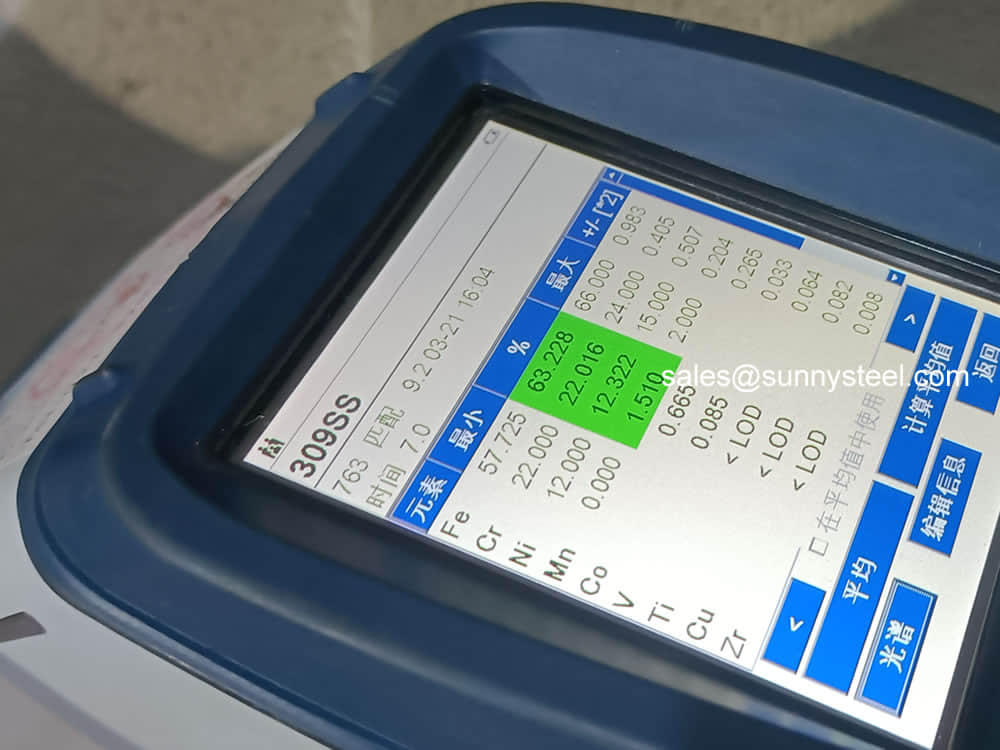
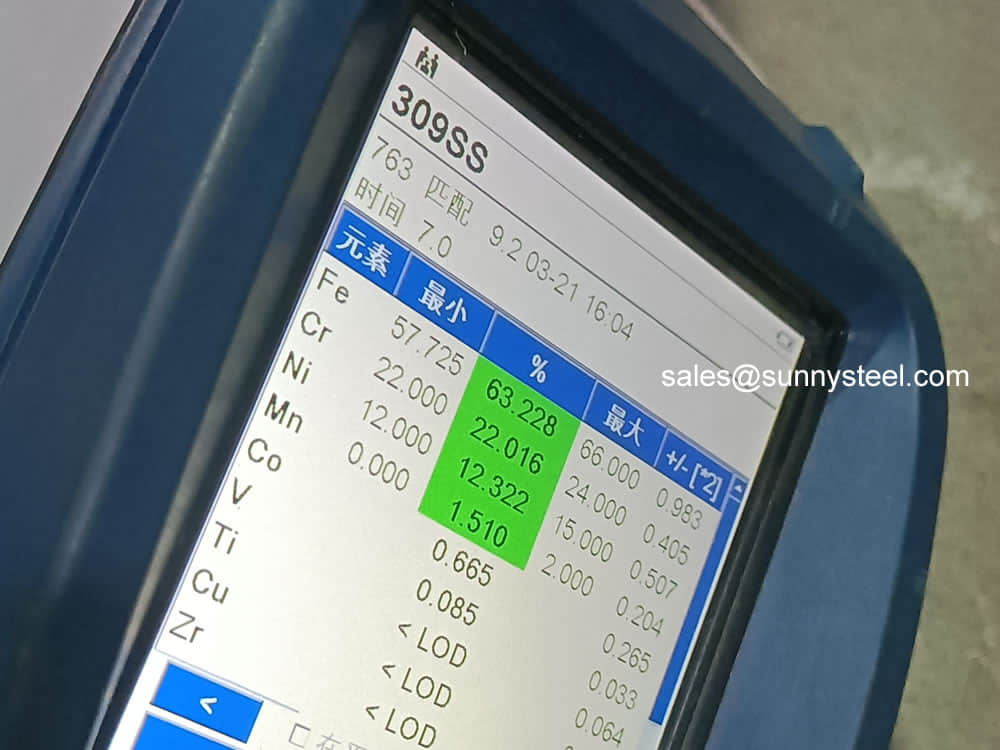
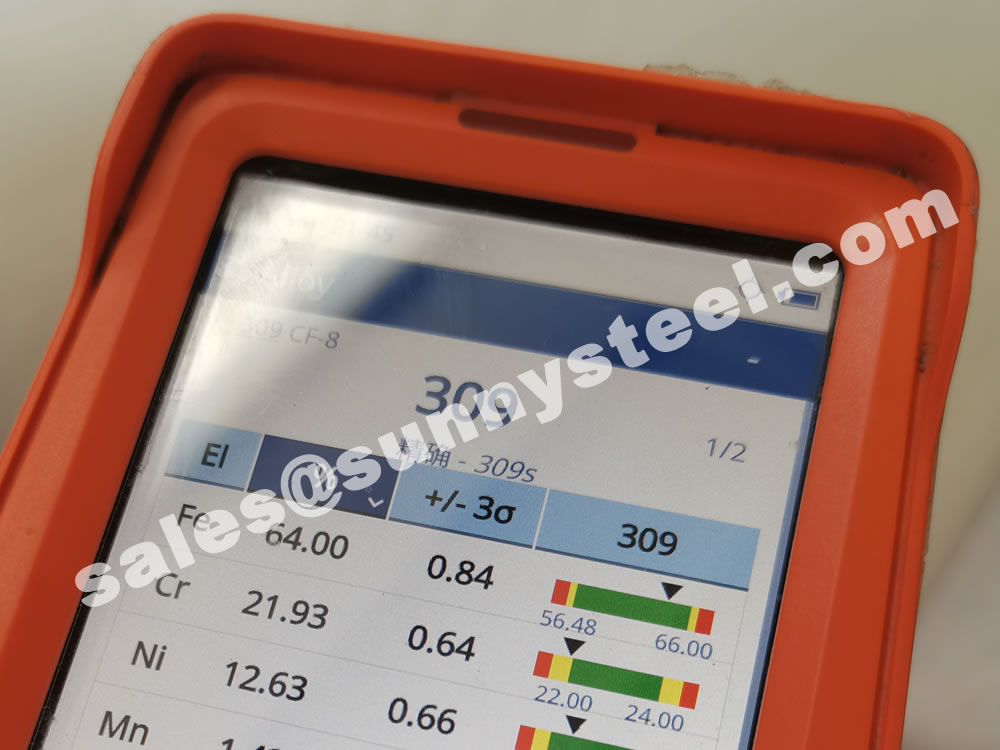
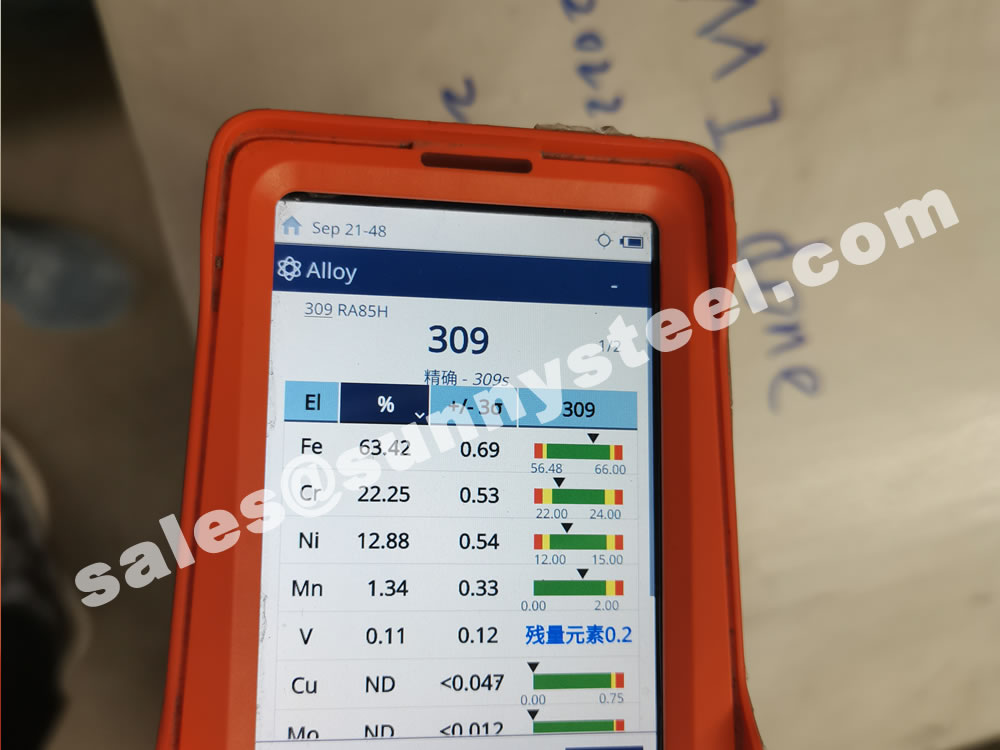
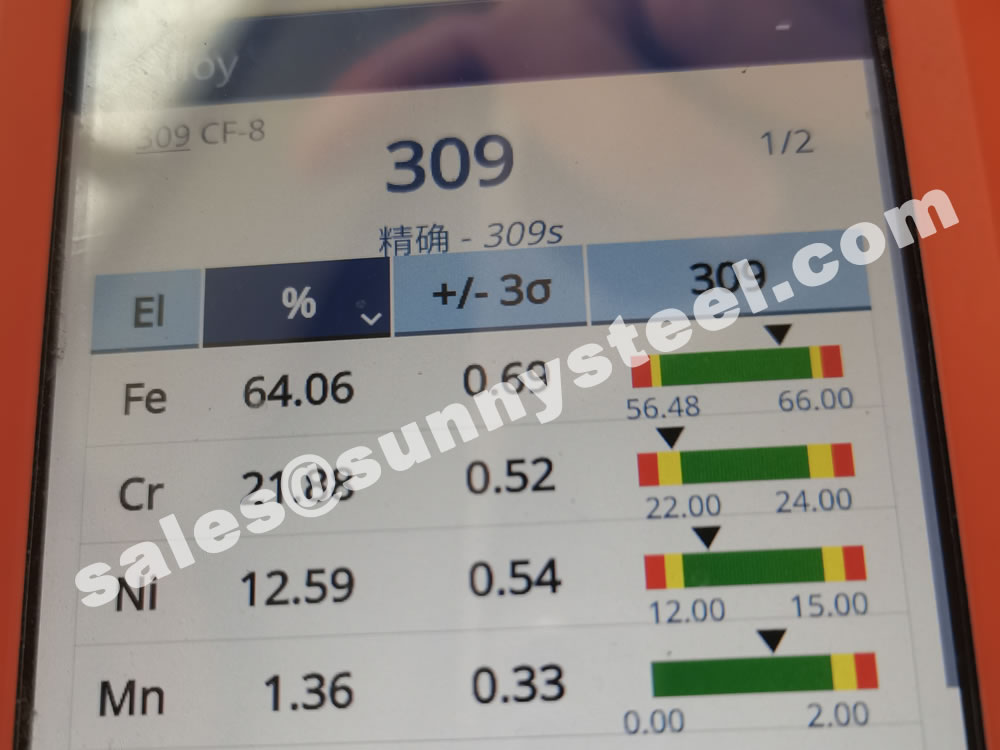
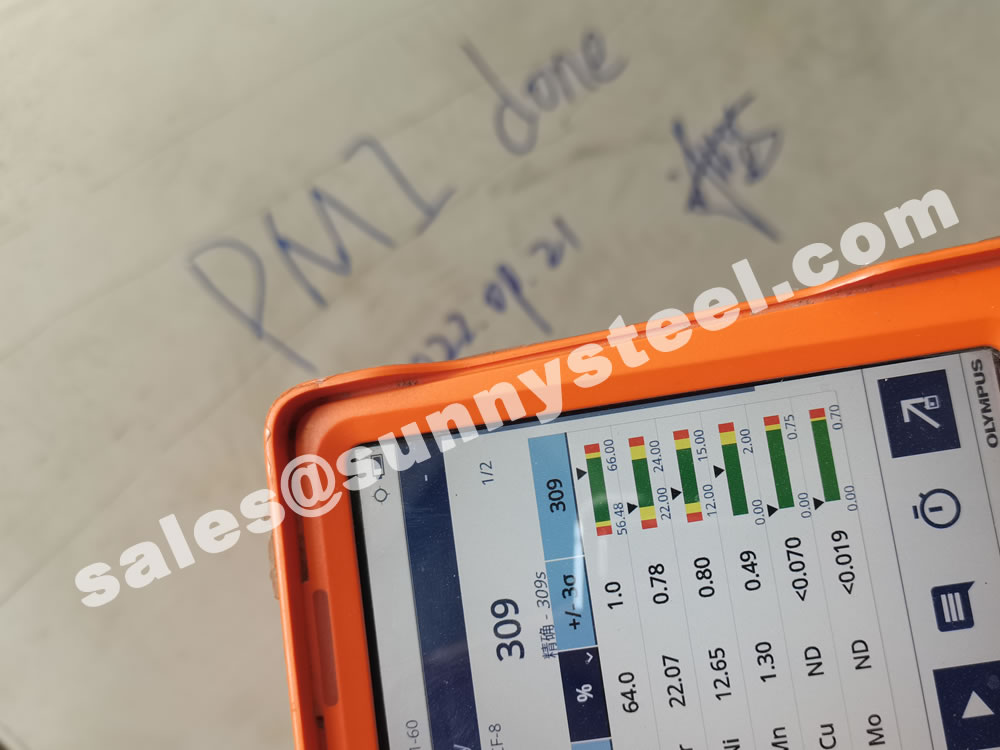
The physical properties of grade 309 stainless steel are given in the following table.
| Properties | Metric | Imperial |
|---|---|---|
| Density | 8 g/cm3 | 0.289lb/in3 |
| Melting point | 1455°C | 2650°F |
The following table outlines the mechanical properties of annealed grade 309 stainless steel.
| Properties | Metric | Imperial |
|---|---|---|
| Tensile strength | 620 MPa | 89900 psi |
| Yield strength (@ strain 0.200%) | 310 MPa | 45000 psi |
| Izod impact | 120 - 165 J | 88.5 - 122 ft-lb |
| Shear modulus (typical for steel) | 77 GPa | 11200 ksi |
| Elastic modulus | 200 GPa | 29008 ksi |
| Poisson's ratio | 0.27-0.30 | 0.27-0.30 |
| Elongation at break (in 50 mm) | 45% | 45% |
| Hardness, Brinell | 147 | 147 |
| Hardness, Rockwell B | 85 | 85 |
| Hardness, Vickers (converted from Rockwell B hardness) | 169 | 169 |
The thermal properties of grade 309 stainless steel are displayed in the following table.
| Properties | Metric | Imperial |
|---|---|---|
| Thermal expansion co-efficient (@ 0-100°C/32-212°F) | 14.9 μm/m°C | 8.28 μin/in°F |
| Thermal conductivity (@ 0-100°C/32-212°F) | 15.6 W/mK | 108 BTU in/hr.ft².°F |
Other designations equivalent to grade 309 stainless steel are included in the following table.
| Standard 1 | Standard 2 | Standard 3 | Standard 4 |
|---|---|---|---|
| ASTM A167 | ASME SA249 | ASTM A314 | ASTM A580 |
| ASTM A249 | ASME SA312 | ASTM A358 | FED QQ-S-763 |
| ASTM A276 | ASME SA358 | ASTM A403 | FED QQ-S-766 |
| ASTM A473 | ASME SA403 | ASTM A409 | MIL-S-862 |
| ASTM A479 | ASME SA409 | ASTM A511 | SAE J405 (30309) |
| DIN 1.4828 | ASTM A312 | ASTM A554 | SAE 30309 |
The presence of nickel gives 304 stainless steel its corrosion resistance and makes it suitable for various general-purpose applications. 2. 309 Stainless Steel: Compared to 304, 309 stainless steel contains a higher percentage of chromium and nickel, typically around 23% chromium and 12% nickel.
Type 309 is employed for parts requiring both corrosion and heat resistance and oxidation resistance up to 2000 °F. Strength at elevated temperatures is similar to that of 18-8 Stainless Steels. This alloy posses excellent resistance to oxidation as well as high tensile and creep strengths at elevated temperatures.
Type 309S Stainless Steel is identical to Type 309 except for a lower carbon content that minimizes carbide precipitation and improves weldability.
Use 309L (including ER309LSi) when joining mild steel or low alloy steel to stainless steels, for joining dissimilar stainless steels such as 409 to itself or to 304L stainless, as well as for joining 309 base metal.
316 contains a minimum 2.0% molybdenum which makes it much more corrosion resistant than 304 however, as it is a more expensive element, generally makes 316 a more expensive grade of metal.
309 has a machinability rating of 43% relative to AISI B1112 steel. Room temperature forming is suggested. Weld with AWS E309-16 covered electrodes or ER309 bare wire. Some Rod Coil is stocked as 309E which is EN 1.4828.
| 309 | 309S | 309H |
|---|---|---|
| UNS S30900 | UNS S30908 | UNS S30909 |
| ASTM A240 | ASTM A240 | ASTM A240 |
| ASTM A480 | ASTM A480 | ASTM A480 |
| ASME SA240 | ASME SA240 | ASME SA240 |
| AMS 5523 | AMS 5523 | AMS 5523 |
Cannot be hardened through heat treatment because the consist solely of austenite at room temperature. Higher tensile and yield strengths that can be obtained through cold working and not followed by full annealing are not stable at the higher temperatures where these alloys are used. Creep properties can be negatively affected by the use of cold worked material at these higher temperatures.
Can be roll formed, stamped, and drawn readily. In process annealing is often required to reduce hardness and increase ductility.
The austenitic class of stainless steels is generally considered to be weldable. Generally considered to have weldability equivalent to the most common alloys of the austenitic class 304 and 304L. Special consideration is needed to compensate for a higher coefficient of thermal expansion to avoid warping and distortion.

When you partner with Sunny Steel, you can stop worrying about meeting deadlines thanks to our responsive and timely service. You'll also say goodbye to unnecessary shopping around. Instead, you'll get white glove service from an expert who understands your needs and can get you the materials you need quickly.
